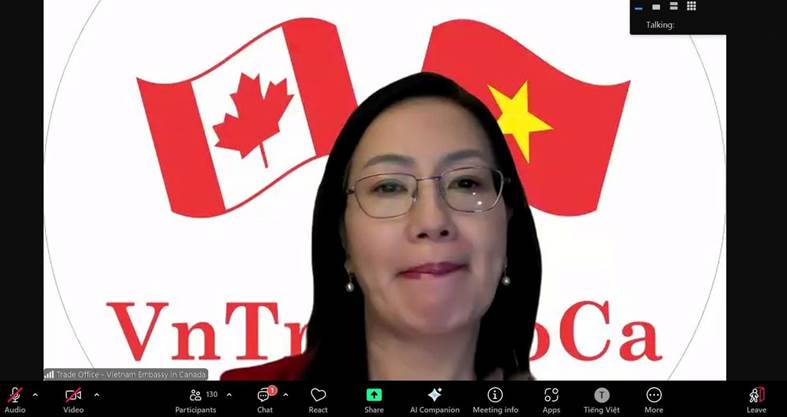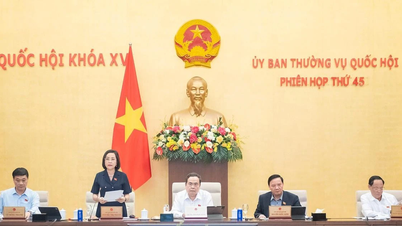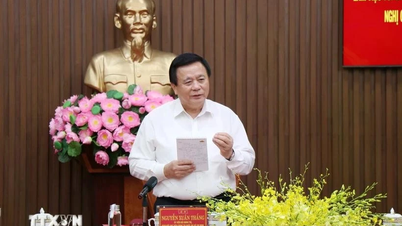The workshop attracted representatives from many agencies: Vietnam Trade Office in Canada, Consulate General of Canada in Ho Chi Minh City, TFO Canada, Export Development Agency of Canada, Trade Services Canada and many representatives of industry associations, localities and businesses of the two countries.
Speaking at the opening of the workshop, Mr. Hoang Minh Chien - Deputy Director of the Trade Promotion Agency ( Ministry of Industry and Trade ) said that Canada is one of the leading potential markets with an open economy, diverse demand for goods, large purchasing power and a high standard system, acting as an important gateway for Vietnamese enterprises to access the North American supply chain more deeply. In particular, the fact that both countries are members of the Comprehensive and Progressive Agreement for Trans-Pacific Partnership (CPTPP) has created favorable conditions to promote bilateral trade cooperation, through commitments on tariff reduction, market opening and procedural reform, many key export industries of both sides have more opportunities to access partner markets, contributing to promoting import and export growth in a substantial and sustainable manner.
Mr. Hoang Minh Chien - Deputy Director of the Trade Promotion Agency spoke at the Workshop
Ms. Jasmin Wahhab, Head of Trade Section, Consulate General of Canada in Ho Chi Minh City, commented that trade relations between Vietnam and Canada have grown strongly, especially after Vietnam joined the CPTPP.
Ms. Tran Thu Quynh - Trade Counselor of Vietnam in Canada emphasized the similarities between Vietnam and Canada in their views on globalization, an open and rule-based world trade system, improving the effectiveness of international institutions, diversifying supply sources to reduce dependence on one market. The governments and business communities of both countries understand the importance of expanding the signing of FTAs to access diverse markets and build resilient supply chains, and therefore, this is an opportunity for businesses to access the 4.4 billion consumer market of the FTAs of which both countries are members.
“Canada is the 11th largest importer in the world with an import value of about 310 billion USD of items such as: electronic equipment, iron and steel, food, consumer goods…”, Ms. Tran Thu Quynh said.
In recent years, trade relations between Vietnam and Canada have been continuously expanded in both scale and depth. Vietnam is currently Canada's 7th largest trading partner and ranks first among ASEAN countries, accounting for nearly 45% of Canada's total imports from the region. In 2024, bilateral trade turnover will reach about 7.2 billion USD, of which Vietnam will export more than 6.3 billion USD to Canada and import nearly 0.8 billion USD from Canada.
Ms. Tran Thu Quynh - Vietnamese Trade Counselor in Canada
Vietnam’s main export items include textiles, footwear, wood and wood products, seafood, coffee, electronic components, machinery and equipment, etc., which are all highly appreciated by Canadian consumers for their quality and competitive prices. In return, Canada is a reliable source of high-tech agricultural products, processed foods, fertilizers and industrial raw materials.
However, Mr. Hoang Minh Chien commented that, besides positive results, trade activities still have some problems. Instead of exporting directly, a significant portion of about 4 billion USD of the total turnover of Vietnamese goods entering the Canadian market goes through intermediary distribution channels located in the United States.
According to Mr. Hoang Minh Chien, the main reason for this situation is the operational characteristics of the North American supply chain, where many large retail corporations such as Walmart, Costco, Amazon, Wayfair, etc. have set up logistics centers in the United States to serve the entire North American market. This distribution model partly helps Vietnamese goods reach Canadian consumers more easily by taking advantage of modern infrastructure and distribution capacity. However, this form also poses many challenges in controlling the target market, improving the capacity to build a national brand, as well as optimizing added value and developing sustainable exports in the long term.
Ms. Jasmin Wahhab is Head of Commercial Section, Consulate General of Canada in Ho Chi Minh City.
In addition to the distribution channel issue, Vietnam's export products still face some limitations in deep processing capacity, unclear brand recognition and uneven quality. This causes many product groups, especially agricultural products and food, to have high output but the export value is not commensurate, and most of the profits are still shared through intermediaries.
Ms. Tran Thu Quynh added: Vietnamese exporters are still less interested in the Canadian market due to factors such as: long geographical distance, high quality requirements, price requirements, etc. Besides, Canada is a rather harsh market for agricultural products and processed foods because many competitors are capable of supplying similar products at more competitive prices.
According to Ms. Tran Thu Quynh, it is necessary to make more effective use of the CPTPP Free Trade Agreement because the rate of using tariff preferences for Vietnamese exports to Canada is still very low, only reaching 18%. With the structure of goods/input materials of the two countries being complementary rather than competitive, she believes that the production chains of the two countries have many opportunities to cooperate. She assessed that exploiting FTAs in general and CPTPP in particular is not only about exploiting tax incentives to promote short-term exports but also about greater opportunities for connecting production/investment/technology/brands between the two countries to create a higher value chain. Accordingly, exploiting FTAs is not only about promoting exports; but also about building an industrial strategy based on the strengths and complementarities between FTA partners with great compatibility such as Canada and Vietnam. In addition to trade connectivity, maritime connectivity between Vietnam and Canada is also a prospect for the two countries to become important links in the supply chain connecting Southeast Asia with the East Coast of North America, enhancing the role of both in global trade and creating new business activities for the transport and logistics sector.
To promote exports to the Canadian market, according to Ms. Tran Thu Quynh: businesses need to proactively research competitors, market trends and industry opportunities; proactively exploit new business forms (e-commerce, online auctions, etc.), take advantage of FTAs, etc.
Businesses also need to pay more attention to website construction, focusing on post-harvest preservation, packaging design, user manuals and product quality standards in English (Halal, ISO, VietGap, GlobalGap...).
The workshop attracted a large number of delegates.
Mr. Brian Staples - Director of the Canadian Trade Service: businesses need to take advantage of the incentives of the CPTPP Agreement to access the Canadian market, learn carefully about the supply chain, rules of origin... Once you have all the data on the supply source, businesses can apply the appropriate CPTPP rules of origin to determine whether your goods are of origin or not.
Sharing her experience from the perspective of a business present in the Canadian market, Ms. Thach Vu Thuy Linh - Chairwoman of the Board of Directors of Renso Foods Company said that Vietnamese businesses need to gather together to build and develop Vietnamese brands in this market. Because products from exporting countries in the region are dominating Vietnam's strong products. For example, in large supermarkets in Canada, pho products "made in Thailand" are appearing a lot, or fish sauce products "made in Hong Kong", "made in Thailand" are also dominant.
In addition, the Canadian market is very strict, especially when this country supports universal health care, so it controls imported products even more strictly. Therefore, before entering the market, businesses must review whether they meet or not meet any criteria. If necessary, businesses cooperate to build a production chain, instead of each business making a product competing with each other.
Source: https://moit.gov.vn/tin-tuc/xuc-tien-thuong-mai/tang-cuong-xuc-tien-thuong-mai-sang-thi-truong-canada.html
























































































![[OCOP REVIEW] Tu Duyen Syrup - The essence of herbs from the mountains and forests of Nhu Thanh](https://vphoto.vietnam.vn/thumb/402x226/vietnam/resource/IMAGE/2025/6/5/58ca32fce4ec44039e444fbfae7e75ec)






Comment (0)